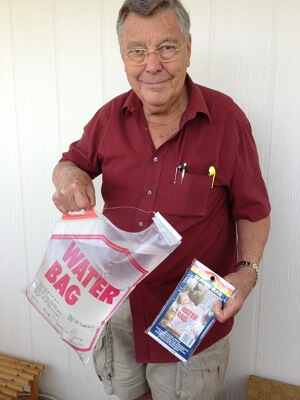You know by now: you can live without food, but not without water.

2 gallons, carryable, collapsible
The recommended amount of water to sustain a person during an emergency is a gallon a day.
Basic 3-day emergency preparedness thus takes 3 gallons per person.
How big is your family? Storing enough water for all family members for at least three days means having space for a lot of bottles!
Emergency water storage options
Realizing that water storage is the biggest challenge, we’ve recommended a number of options.
If you can, buy a 55 gallon drum. Fill, store at home. Full, the drum weighs around 460 lbs. so you need to consider where to keep it and how to get the water out. (Typically, you get a hand pump that fits the hole of the drum.)
The next best option for you may be to store individual bottles that can be spread around the house and rotated regularly. This is usually the choice of apartment dwellers, given their limited storage space and their need to haul supplies up and down stairs.
A third option is to store as much water as you can, but supplement with a water filtering device and collapsible containers that you fill as the storm approaches!
Don’t overlook a LifeStraw water filter.
As we were putting together our recommendations for our custom survival kit, water was clearly the toughest item to store. We looked for a way to improve on the water supply stored in the kit. The first choice was to add a LifeStraw – the one-person water filter that can make found outdoor sources of water drinkable. It costs around $20, and you’ll want one for each member of the family.
LifeStraw Personal Water Filter for Hiking, Camping, Travel, and Emergency Preparedness
Add collapsible water bags or bottles to supplement your supply.
The second choice is to supplement your stored water with collapsible water bottles that you fill immediately with whatever clean sources of water are still available. Our research led us to consider:
* Carrying handle. Frankly, carrying water is very difficult. You know this if you’ve ever filled a five-gallon pail and tried to carry it any distance at all! So, we looked for some sort of closed container that is easy to fill and that has a carrying handle.
* Weight of the container when full. A full five-gallon plastic jug weighs nearly 50 lbs. Too much for me! (and most people) to carry for any distance, or up and down stairs. So, we looked for a smaller container, holding 2 or 2 1/2 gallons.
* Sturdiness of the container. Of course, reusable rigid plastic jugs are very sturdy, almost unbreakable. However, our goal was to find a collapsible bag that would be filled only when needed. Remember, the very thing that makes the collapsible bag convenient means it’s not as sturdy as you might want. We reviewed a number of manufacturers and selected the one with the best reports for durability. Don’t expect perfection — so buy more than one bag.
The best collapsible water bag? StanSport’s 2-gallon Water Bag.
Our search led us to the 2 gallon Water Bag manufactured by StanSport. The photo above shows Joe with a full bag. A collapsed bag is in his other hand.
Stansport 2-Gallon Water Storage Bag
We have several of the bags. We tuck a couple into the Survival Kit, and have another in the glove compartment of the car.
If you click on the link or image, you’ll be taken to Amazon, where you can order. If you combine your order with another item – for example, the LifeStraw – you’ll get free shipping from Amazon. (You can also buy the water bag from other sites, including StanSport’s site – cheaper at first, but when you add shipping costs, they all come out about the same – without the convenience and speedy delivery.)
Do you have a favorite water storage container? Or a water storage story? We’d like to hear it! We are constantly on the lookout for better water storage options for surviving a disaster.
Virginia and Joe
Your Emergency Response Team
Other resources you may want to take a look at:
Don't miss a single Advisory.
Thank you for subscribing.
Something went wrong.


